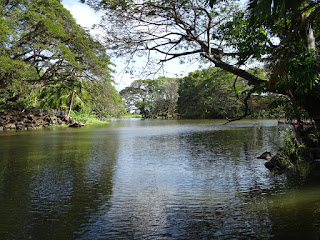 |
| At the crater of Mt. Maysaya. We could hear the lava rumbling below the sulfur cloud. |
 |
| A typical side street |
Granada is one of the most colorful and tourist user-friendly towns we have visited in quite awhile. Founded in 1524 by the Spaniards, it is one of the oldest cities in the New World. It was burned in 1856 by William Walker, an American filibuster (one who conducts unauthorized warfare), then rebuilt and fairly-well maintained ever since. It has many huge haciendas, now mostly converted into hostels, B&Bs, and hotels.
 |
| A former hacienda that's now a good restaurant |
The people are friendly, but pretty much ignore the tourists unless they have something to sell, and even then they take a polite "no" for an answer and move on. We wish we knew more Spanish (or even some Spanish) to strike up conversations with them.
With so many 20-something travelers in short-shorts and tank tops sporting backpacks, we're probably in the upper age demographic here. (But, hey, we also have backpacks.) But every now and then we see a procession of older tourists being herded around by a tour leader, and occasionally families or older couples in one of the many fine eateries here.
 |
| Fishing among the islets of Lake Cacibalaca |
 |
| Cruising among the small islands |
Granada sits beside the huge Lake Cacibalaca, conveniently located to volcanoes, island resorts, and the Pacific Ocean. In fact, it was the main overland transit point for the California Gold rush.
We visited the Mombacho and Masaya volcanoes and enjoyed a boat ride among some small islands that were created by Mt. Mombaco belching giant boulders into the lake. We also briefly visited the town of Masayya at the foot of that active volcano.
 |
| Mt. Mombacho. We hiked partly around it |
 |
| An old fortress in Masaya, now an artisan market |
It's been a pretty laid back four nights here. It is so unbelievably hot and humid here that we basically accomplish one big thing per day, then retreat to our $50 per night hacienda and it's plunge pool, read, and rediscover the lost art of afternoon naps.
 |
| A slot canyon near the rim of Motombu Crater |
 |
| The overgrown Mombacho crater |
On Thursday we finally get to meet Jasmine, a Peace Corps volunteer (and Nati's girlfriend) an hour south of here. The four of us will take the ferry to the Ometepe Island and stay at a B&B on an organic farm.
 |
| Ahhhhh! The plunge pool in our $50 per night hacienda. Most hostels and hotels have them |

I love the stories...I’d hate the constant heat. Again, your photos tell many beautiful stories.
ReplyDelete